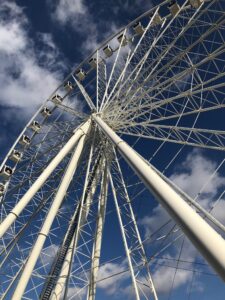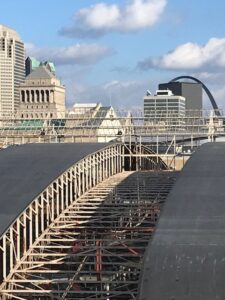Glowing at the west edge of downtown, the new St. Louis Wheel rounds out the city’s geometry. We have the rectangular high-rises, the diamond points of Union Station’s red tile roof; the diagonal lines, like thumb-tacked string, of the Stan Span; the sharp angles of Lumière Place casino; the gentle arches of Eads Bridge; the loopy parabola of the Arch itself. We used to have the pure circle of the old stadium, but somehow the new one squares the circle, so we needed this wheel.

The St. Louis Wheel
We needed it all the more because of what it represents.
Circles are about unity; they do not privilege one element over another. There is no spatial division, no spatial hierarchy. And St. Louis is a city too often divided against itself. Redlining and white flight have zoned sameness, turning high- and low-income neighborhoods alike into enclaves suspicious of any outsider.
But set that aside: Today is for fun, for novelty. Shaking off civic discontent, I climb into my seat and—with a low rumble, as though we are in a peckish giant’s tummy—the Wheel begins its slow revolution. Alone in the little pod, I gawk, peer, change sides, take pictures. These are fresh angles, ways I have not seen the city before.

One of many, many views
Granted, the view could be better; one sees only the top of the Arch, which is like looking only at the tip of a paper clip and thus failing to comprehend its identity and ingeniousness. “The tall buildings get in the way,” one of the guys herding us into line said regretfully. There is no sense of the cleared grandeur of the mall in front of the Arch; no sight of the river T.S. Eliot called “a strong brown god.” The best views are of police headquarters, a busy place these days; the Wells Fargo and Salvation Army signs, in direct opposition; and the Thomas F. Eagleton United States Courthouse, which dwarfs the limestone elegance of the Civil Courts Building.
Like a dowager at a ball, I gaze down at the buildings, noticing how they are clad, which are beautiful, where there is conversation, flirtation, relationship. This is only possible during the day, when the Wheel gleams white in the sunshine. It is at its best, however, at night, when the old magic of electricity reasserts itself. The changing colors and lit-up city, literally transformed, remind me of the gasps we would have heard at the turn of the last century.
I do miss the old open-air Ferris wheels at carnivals, where you could feel the sun and breeze and hear the shrieks and lean forward or back, sliding a terrifying inch or two closer to a fall that was, one hoped, technically impossible. Enclosed in the climate-controlled pod, I can barely tell when I have reached the highest point. Yet another concession to safety, I suppose. An odd phrasing, as though safety is something we must pay fealty to, an enemy of our freedom. But…it can be.
There are observation wheels in Las Vegas (that one is 550 feet high), Melbourne, London, Atlanta, Santa Monica, Singapore, Berlin, Beijing, Orlando… Soon aliens will decide that a metropolitan area is marked by a lit and slowly revolving wheel. Why this shape, I wonder on the third go, and not a ziggurat, or a giant slide, or a ski-lift sort of ramp and drop?
Because circles please us. They are timeless, cyclical, as soothing as the ride itself, from which one passenger alit saying, “I almost fell asleep!”
Besides, these wheels have a history. The first went up at the Chicago World’s Fair in 1893, created by George Washington Gale Ferris Jr. in retort to a slew of engineers who pronounced it impossible. It was lit by 3,000 of the newfangled electric bulbs, and it stood 264 feet tall, giving fairgoers exhilarating views in all directions. “Sublime in its proportions, wonderful in its ponderous weight,” it would, the Chicago Tribune predicted, “go down in history as one of the wonders of the Century of Wonders.”
(In point of fact, the wondrousness had started years earlier on Staten Island. “There is no novelty to the idea, though there may have been to Mr. Ferris,” a reader wrote to the editor of the St. Louis Post-Dispatch in September 1893. Three decades earlier, he explained, a similar wheel had been erected on Staten Island, “and I rode in one of the boxes swung and elevated in every respect the same.” Another had been erected in Atlantic City, and its owners sued Ferris Wheel Company immediately, even though Ferris had, perhaps craftily, refrained from ever claiming credit for invention. And all of them owe a debt to the man-powered pleasure wheels of seventeenth-century Bulgaria.)
Alas, when the Chicago Ferris Wheel was moved near Lincoln Park after the fair, it “was not the success expected,” reported the Chicago Daily Tribune in November 1896. “When it was seized by Sheriff Pease about ten days ago Mr. Ferris was greatly affected. It is thought this action partly caused the illness that resulted in his death.”
That might have been a stretch; the illness was typhoid fever. He died, in the colorful account offered by the Atlanta Constitution, “on a sick bed, delirious with dreams of wealth which would have been realized had he lived.”
Instead, he left us the Ferris wheel: huge and American, a triumph over the naysayers, an exercise in brazen daring. (It is said he was afraid to go to the opening, lest there be an accident). His wheel was eventually bought for the 1904 World’s Fair in St. Louis, then dynamited in 1906. Because Ferris had prevailed against the lawsuit, his name stuck, a moniker for many a wheel to follow.
This one, however, is not a Ferris wheel, its publicist informs me. It is an observation wheel, the term stressed to remind us that this is a permanent fixture, not a mere amusement or a carnival passing through town.
To me, the Wheel is also a reminder that development in St. Louis has not been a picnic. Looking down, I would redecorate if I could: pretty up the highway and parking lots (why does necessity so often end up ugly?) and spotlight the beautiful historic buildings so the past would not be forgotten.
While I am busy reinventing the cityscape, the Wheel turns for the sixth time. Pod by pod, we “arrive where we started,” as Eliot wrote, “and know the place for the first time.” Or at least know a few of its details a bit better: The potato-chip undulation of the arena’s roof. The distant gothic spire on the bell tower of St. Francis Xavier College Church. The distinctive slanted cap of the old Pet Milk building, a Brutalism that is not the least bit brutal, its planes receding and coming forward in a basket weave to lighten the concrete.
Human beings climb to vantage points to feel safe. Up high, calmed by perspective, we see differently. Sameness is flat and monotonous. The eye seeks what is distinct, colorful, different. The mix is what is interesting.
